Our Paddock Paradise
The inventor of Paddock Paradise: well known equine barefoot trimmer Jaime Jackson, looked at the typical behaviour of horses in wild herds, and worked out a system which could be employed in any domestic horse terrain which would allow domestic horses the freedom to follow their instincts. This is our experience of putting Paddock Paradise into practice.
Changing Philosophy
We have always kept our horses together, in larger or smaller groups depending on the circumstances. Sometimes we would keep youngsters and horses which were resting together, and have those which were working in a different band. It depended sometimes on the grazing land available, or the proximity of the stables. Sometimes how we arranged them depended on the number we were able to feed together outside.
There are always reasons for the way we do things at any one time, but over time we did learn certain interesting truths about managing horses together. These truths underpin the phenomenal success of our Paddock Paradise system today. They are not only the reason it works so well, but the Paddock Paradise system itself brings out the maximum benefit of these characteristics of horse behavior.
The social dynamics of the herd
Horse communities work in hierarchies. The most dominant horses take the lead in terms of deciding where the group goes, and they will have the first opportunity of any food which is available, and the first opportunity to drink at the water supply. The relationships in a domestic group of horses are not always simple, for example a horse may be bossy because he or she is insecure and more motivated to eat, and by the same token the horses which take responsibility for affronting dangers are not always the highest positioned in terms of getting to the food. This may be because in a group of geldings and mares the roles are less defined than they are in a wild herd situation.
What matters though, is that there is always a place for any horse. There may be exceptions if a particular horse has developed serious asocial behaviours, as a result of unnatural segregation, but the only insurmountable complications we have encountered involve stallions and rigs.
The role of a stallion in a wild herd is fundamental, and we can't expect them to fit into domestic scenarios without respecting their powerful instincts. There are always solutions if you put your values first however. Our values are that we are happy when our horses are happy, and no horse is happy on his own. For an example of integrating a rig into a herd look at Our Herds on the Importance of the Horse Herd page.
It is also possible to keep domestic stallions in a fulfilling environment, look at this article: The "natural" life of a champion dressage stallion and his mares at Dogwood Sport Horses
.
Using the Herd Hierarchy To Your Advantage With Paddock Paradise
We have found that the hierarchy of a herd can solve many of your practical problems if you follow its rules. The main reason we used to keep our horses in separate groups was because when we fed them outside we didn't think that we could manage to hand them out their individual feeds in a group of more than four or five without a struggle!
We now have a herd of eleven horses, and we can feed them all individual feeds at once, with a minimum of supervision, because we use the hierarchy. Handing out the feeds in order of the hierarchy is essential, and the horses must also accept people as being higher up the hierarchy than them, otherwise they will not allow you to organize them. For example if there is a horse who has a smaller feed who finishes before a lower-down herd member, it is only possible to prevent stealing easily if that horse respects us as the one who decides! Being fed in this way is an excellent opportunity for horses to improve their manners, and to improve the trust and intimacy within the herd.
In fact it is not only working with the hierarchy which allows us to feed so many horses together, the particular configuration of Paddock Paradise is also essential. This is described in the section below: Paddock Paradise Pro's.
Go to Understanding Horse Herd Dynamics for an account written by Naomi Sharpe, one of our previous working pupils, based on her observations of a horse herd in the US.
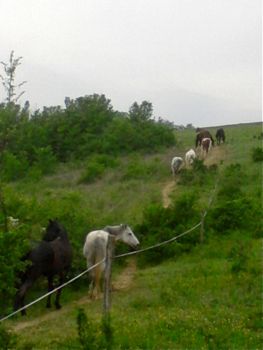
Horses are curious and they enjoy discovering new places and new things to do, as long as they feel secure. Paddock Paradise is the perfect way to bring out your horse's sense of fun and adventure while teasing him out of habits of timidity and institutionalization. Horses will easily slip into this mindset when they only ever go out in a field. We couldn't believe at first when we opened up the lane system to our horses, quite how conventional and unimaginative they had become, considering that they had already had much experience of large and interesting fields. It took them several months to start using the lanes properly. They have never looked back though and now they have a boldness and an assurance which brings out the best in their characters.
Constructing Paddock Paradise
A paddock paradise system has the following features:
- A system of lanes which are roughly 5 metres wide, ideally designed in a circular pattern, avoiding dead ends. The width of the lane can narrow slightly in different places, encouraging the horses not to hang about too much, and wider places for resting can be incorporated also. The lanes encourage the horses to stay closer together when they are moving along, like in the wild herds. We found in most places we could make an inner fence around the outside of the existing fields, and we only had to construct the entire lane when we were in-between fields. We have at least 2 kilometers of lanes now, shared between the two herds, as well as the fields within them of course, which we are able to rest much more often than before.
- We use simple electric fencing with two strands: one wire below because it conducts better over long distances, and one white tape above to give good visibility for the horses. This kind of fencing is secure yet flexible if you need to change your layout.
- The water supply is an important feature of the lanes. If it can be organized in a place which encourages the horses to make a journey away from their hay to get to there, that is ideal. This is an important part of wild horses lives - going to the water hole - and on the lanes it can become a social event, and also a test of courage for those who might have to go on their own. It is only when we could watch the horses in situations like this that we realized how much we confine our horses normally.
- Making the lanes as interesting as possible for the horses is part of the objective of Paddock Paradise. Including steep banks and trees, streams if you have any. One of our herds has a whole wood to themselves, through which they have made their own tracks. We are planning on making a pool where the horses can actually get into the water, where there is a natural spring. Each type of countryside has its own potential. It just requires imagination. Remember that if the terrain is difficult, horses will toughen up and discover agility and balance you won't believe. Our horses gallop and leap about together and move with a grace we had never seen in domestic horses before.
- Our design gives us one main entrance for each lane system with several other possibilities.
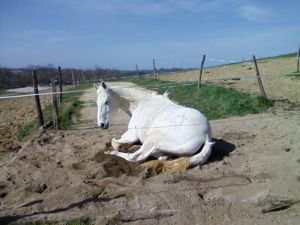
At the main entrance we have leveled the area, put down a geo-textile membrane and sand for the surface. We top it up every autumn and it works very well to keep the gateway mud-free. The horses love lying down in the sand - especially when it's fresh. Sometimes nine or ten horses will lie together.
- We decided not to kill-off the grass, or otherwise alter the vegetation when we made our lanes. The climate where we live is typically dry with clay soil, and grass growth is only abundant in the spring. The pasture tends to have a thin sward, and we knew the grass would be eaten down quickly enough. In fact the evolution of the lanes has been interesting to watch. The most used lanes will go down to earth in the summer, but over time the clay has become less pure and the constant packing down has created a comfortable surface for the horses to move over.
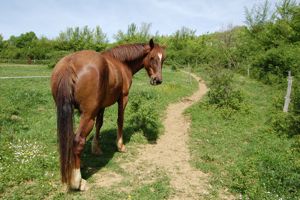
The lanes which are less frequented have narrow paths, sometimes only one and sometimes several, which work their way round bushes and trees which the horses browse on. There is always some grass available under the bushes and along the edges for the horses to pick at in between their hay, so they are never restricted but they do have to work for it.
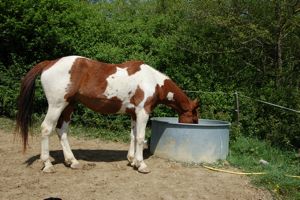
Paddock Paradise Design
This is a map of our own lane system, we have about 33 acres in total, but the concept works for any size of terrain which is big enough for horses.
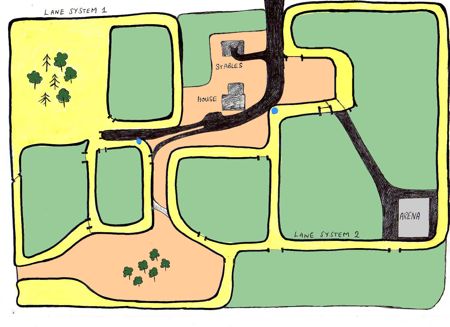
Paddock Paradise Pro's
When horses are accustomed to the lane arrangement, they will learn how to line themselves up according to the hierarchy. This is critical for the smooth operation of feeding time because:
- You can bring the feed bowls right up to the other side of the fence.
- When you hand them out in the pecking order there won't be any fuss or trouble.
- You can supervise easily and intervene if anyone finishes first and goes to steal from a lower member of the herd.
- You can lay the hay out along the fence before you hand out the feeds so dropped food will mostly fall on the hay and not be lost.
- Horses fed in this way don't develop any bizarre habits because they have to behave according to herd rules, usually they are surprisingly patient.
Making the most out of your land. A lane system encourages your horse to use the land you have better while allowing you to rest your fields when it suits you, such as:
- Whenever the spring or autumn flush of grass is growing
- When your horse is overweight or prone to laminitis
- If you have enough land to make hay
- If you want to let your grass grow longer so it is less rich for the horses.
It also gives you much greater flexibility as to where you can access your horses to feed them and give them hay. Basically you can do this wherever you have a perimeter that you can access, because the lane allows you to feed horses along any fence-line, either from the outside, or from the interior field or area. This means that whenever mud is a problem, you can change where you feed and distribute hay to somewhere that is cleaner.
The photo below shows how we are able to feed and hay eleven horses outside in the winter, even when our clay-soil normally makes mud a big problem, because we can access them from a gravel area alongside the lane where we can easily distribute hay and feeds from a trailer/quad.
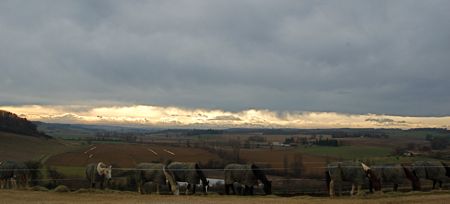
Some have already been mentioned but the benefits for you horse are numerous:
- Encouraging your horse to lead the kind of lifestyle he has evolved to, which will improve his mental and physical health beyond measure. The main features of this lifestyle (which differ from the usual one-horse-in-a-small-flat-square-field scenario) are that he can explore, he has to interact with his environment as well as the other horses to find food and water. Imagine how different our lives would be if we had to go and find fruit on the trees instead of just going to the fruit bowl. It is equivalent for a horse. Convenience can easily become an enemy.
- The Paddock Paradise system is the only viable solution to the fact that most European pasture is unsuitable for horses. Arguably the most serious consequence of this high sugar diet being the damaging influence on the horses feet, see The Horse Diet and its Importance in Hoof Care and horse nutrition for more info. Paddock Paradise allows you to control the amount of grass available to your horse at the same time as keeping life interesting and keeping him moving. Replacing the grass diet with hay means that your horse is still getting the necessary levels of fibre in his diet.
- The lanes provide horses with an environment that they have to make a real effort to negotiate. We have noticed a remarkable improvement in the balance and agility of all of the horses as well as the resilience of their limbs and suppleness of their joints. Despite the fact that they perform impressive acrobatic feats every day, it is very rare for them to sustain an injury.
- Another helpful feature of the Paddock Paradise system is the ease with which you can integrate new horses.
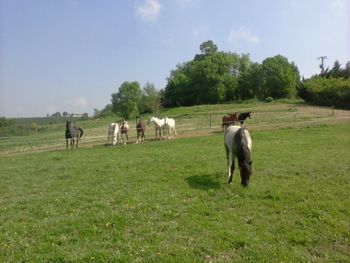
The new horse(s) can go in the field beside and will be able to speak to the whole herd without direct contact. You can judge at your own leisure when you think the integration can be completed.
Paddock Paradise Problems and Procedures
Like all programs of rehabilitation (which is essentially what installing Paddock Paradise for you horse will be) it won't always be plain sailing. You will have to find solutions to your particular circumstances. Some of the teething problems we had to resolve were:
- Originally we would put the hay out very thinly along long stretches of the lanes to encourage the horses to explore and move along. This worked very well but it was just too time consuming, so now we still lay the hay out along the edge, but along stretches we can access with the quad and trailer, so less thinly and less far down the lanes. We find that very little is wasted because the hay is under the bottom strand of the electric wire, and there is always a clean grass surface because the horses can't walk there, but they do graze it down. In fact this system works well, because when they are finished or have had enough hay, they will go off to browse or pick at grass along the lanes because they are not institutionalized to standing around in the same way as before.
- The climate where you live will be important for how you arrange your lanes and your fields. Where we are in the South of France it is often quite dry which suits the lanes perfectly. We did find that at first when it was wet, the lanes would get very slippery because of the clay soil, and at those times we would use the fields. Over time the lanes have become flatter and the surface has improved so the wet isn't quite so prohibitive. We do have quite sleep gradients here too which makes the slipperiness more of an issue.
- The horses' droppings can tend to accumulate more apparently on the lanes than in a field, because the horses are closer together in areas where they eat their hay and so on. Obviously you don't want to be putting hay down for them next to where there are droppings, so what we do is to simply rake them down onto the opposite edge of the lane from where we distribute the hay, before we put it out - it is very quick and easy to do this. We find that it only takes the occasional heavy rain-shower to wash the droppings off the lanes completely, especially where there is the advantage of a slope.
- Paddock Paradise does highlight how well your herd integrates. The horses have to accept the rules, and we found in the first months that some horses who had never really interacted properly with the others (usually the more timid or offhand ones) would always seem to get themselves in a place without hay and make no effort to help themselves. Other more dominant ones would sometimes upset the order and barge through the line causing a domino effect!
It really does pay off to be patient though, as these issues not only ironed themselves out, they did so because the horses became more socialized. They were becoming normal again, as horses should be.
- The lanes can be organized in such a way that you can separate a particular horse from the others etc. For example we have a new mare who is at the bottom of the line and eats particularly slowly, so we put her in a little holding pen where no one can hassle her and we don't have to supervise her when there are other things to do. You can see our horses eating in line on our YouTube video.
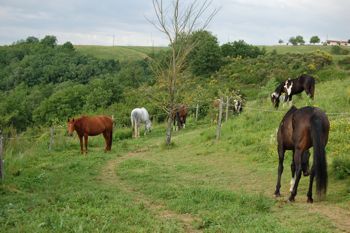
Below is an aerial view of our farm. If you look closely, or zoom in, you can see the lighter tracks indicating the network of lanes around the Paddock Paradise system, with the fields in between, and the dressage arena in the bottom left corner.
Agrandir le plan
Click here to go to Jaime Jackson's own Paddock Paradise site
Relevant pages on Happy Horse Training that may interest you:
The Importance of the Horse Herd
Understanding Horse Herd Dynamics
Natural Horse Hoof Care
Horse Nutrition
The Horse Diet: Its role in hoof care
return from Our Paddock Paradise to Happy Horse Training home
Join the Whole Horse Newsletter
HHT's free monthly newsletter, giving you wide-ranging insights into holistic horsemanship.
Just enter your details below to join.
Click here to see back issues of The Whole Horse newsletter
Learn How To Trim
Your Own Horse's Feet
The Simple Seven-Step Natural Trim is a comprehensive step-by-step guide to a cutting-edge barefoot trim. Click here to find out more.
Do You Have
A Horse Story
To Share On HHT?
So many people have been through wonderful experiences with horses, whether in training or otherwise. If you've made a change in a horse's life - or one has made a change in yours - tell us about it here.
Train Your Horse
The Holistic Way
How To Train A Horse Without Force is a unique guide to training horses through energetic connection and gymnastic training. Part 1 covers everything on the ground, from handling to the lungeing technique that develops strength, straightness and engagement. Comes with a free eBook supplement on Horse Trauma.
Click here for more details.





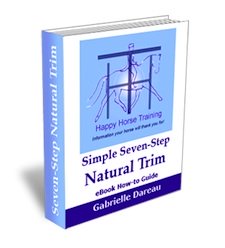
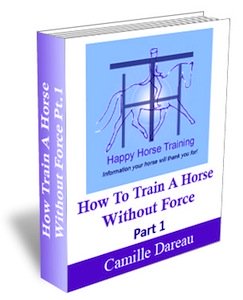

New! Comments
Anything to say about this page? Leave your comment in the box below.